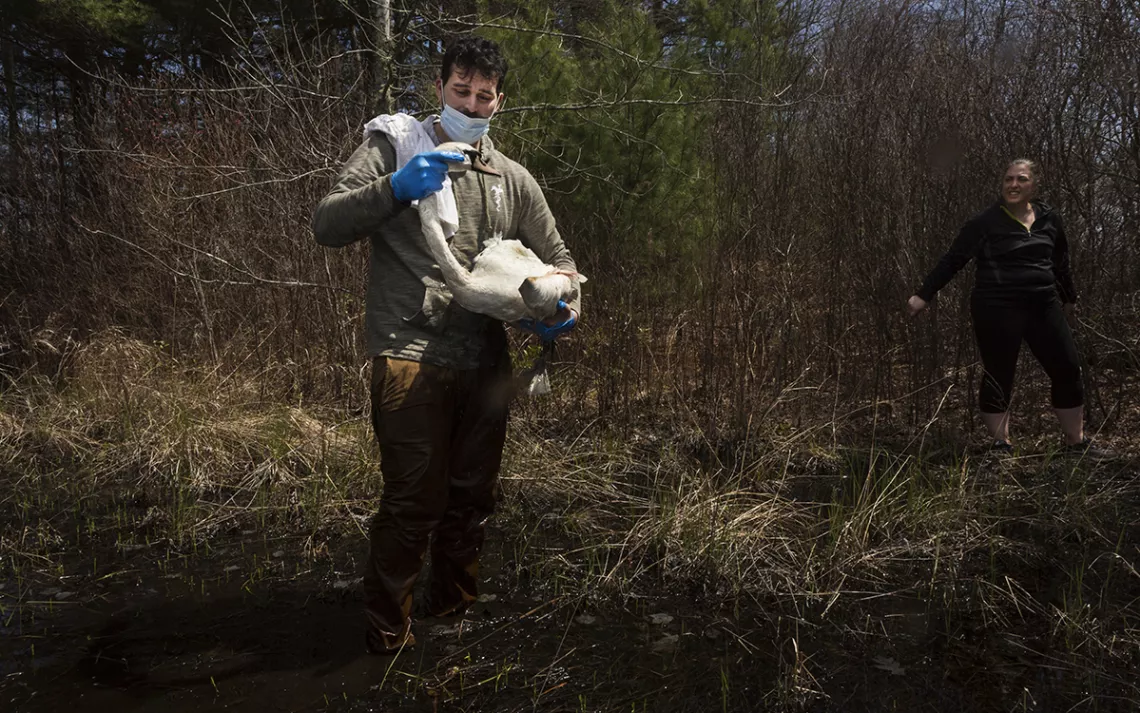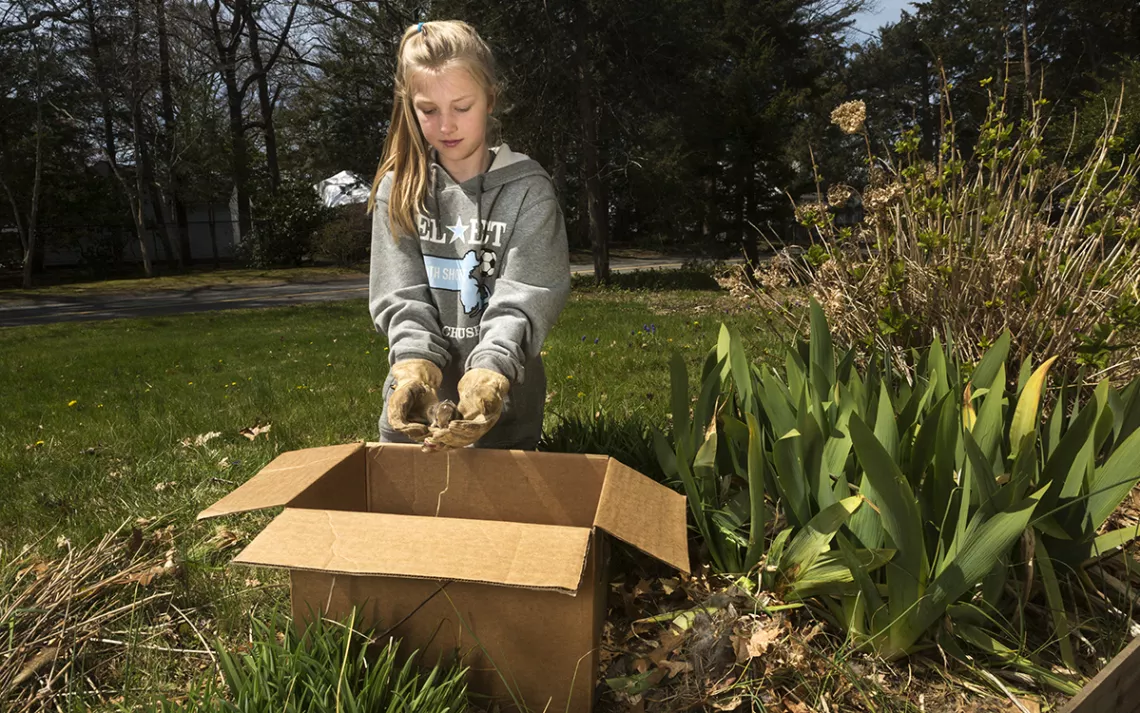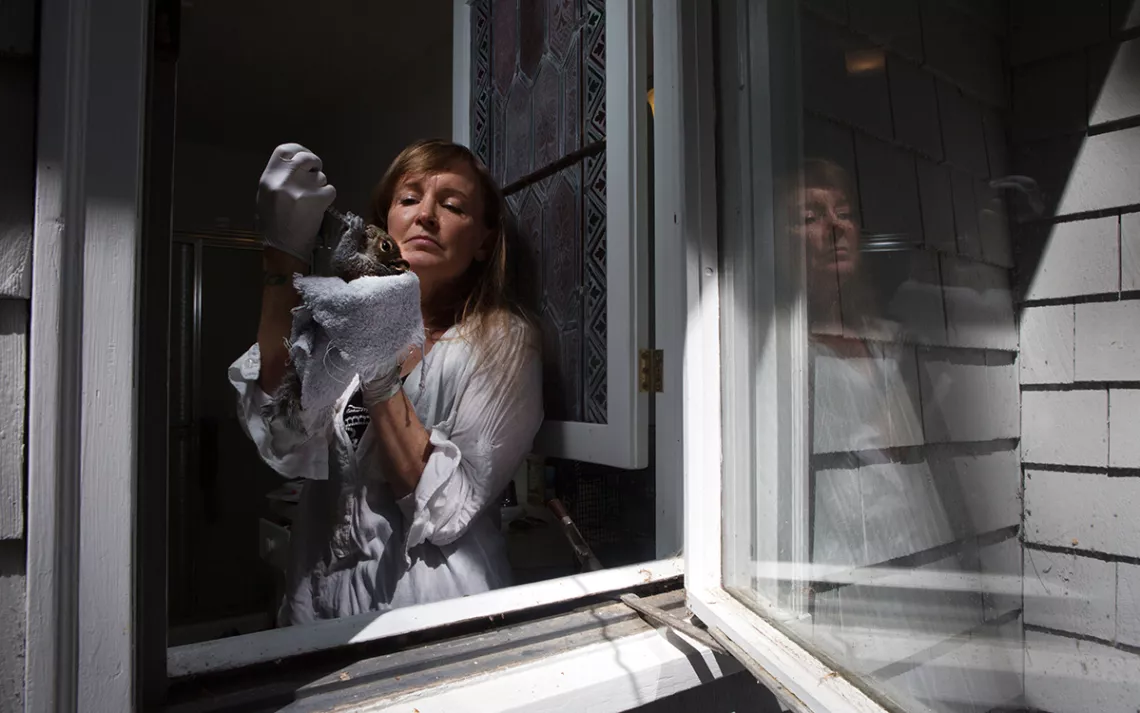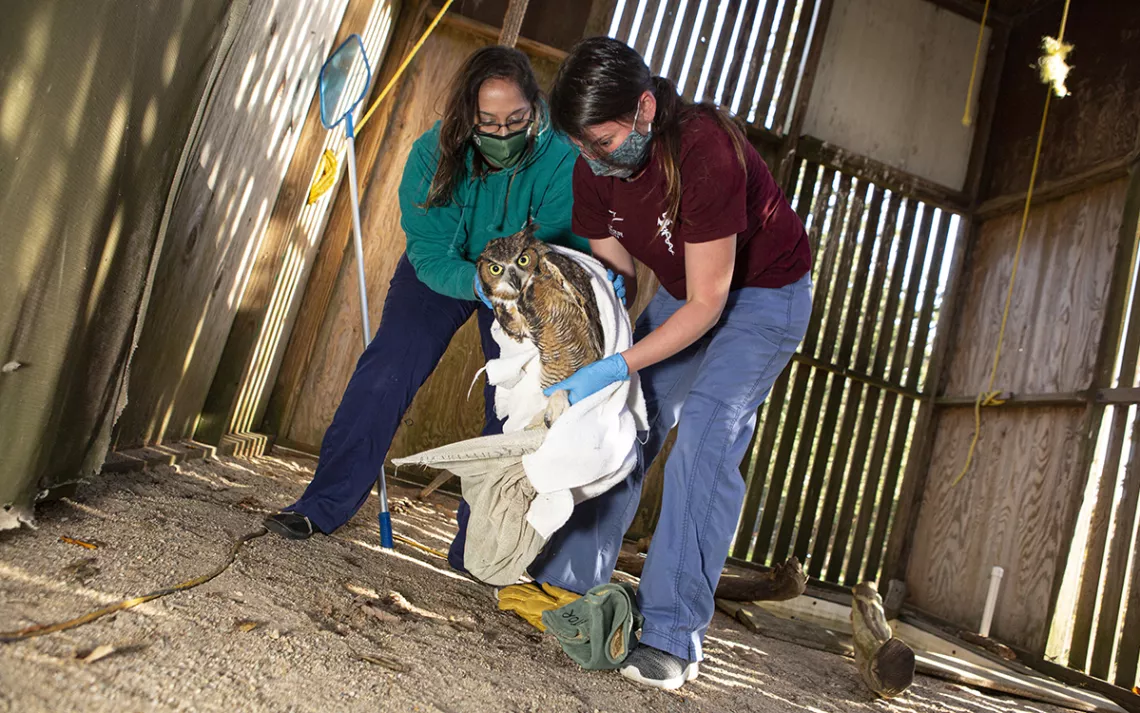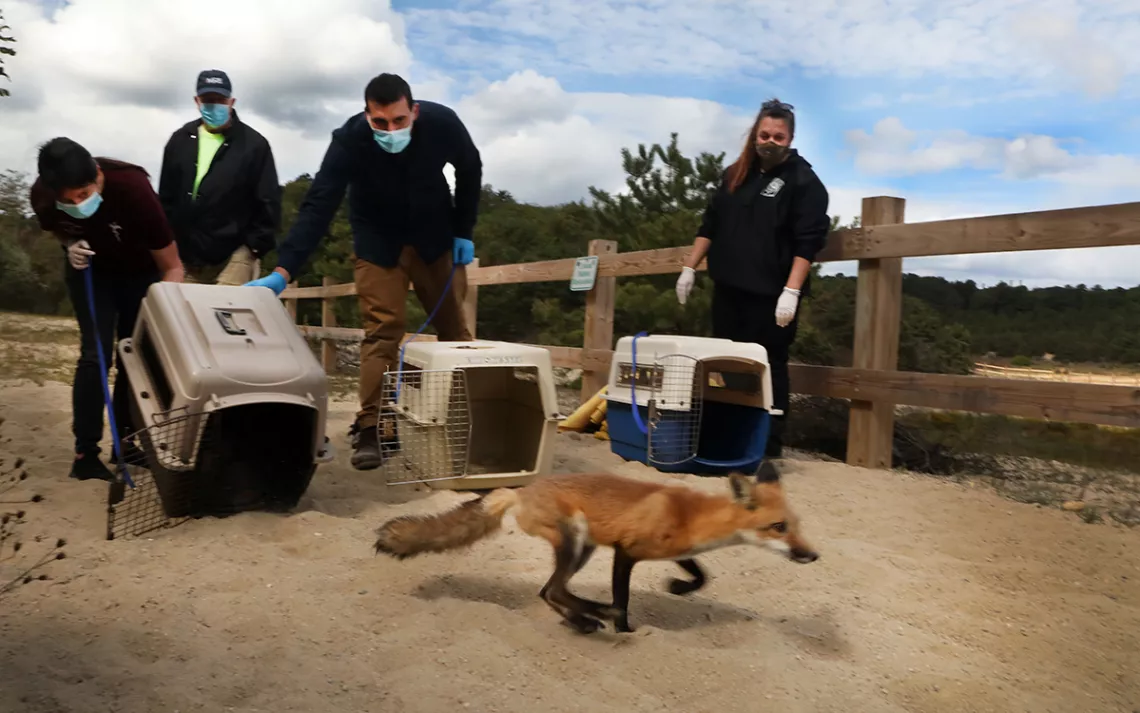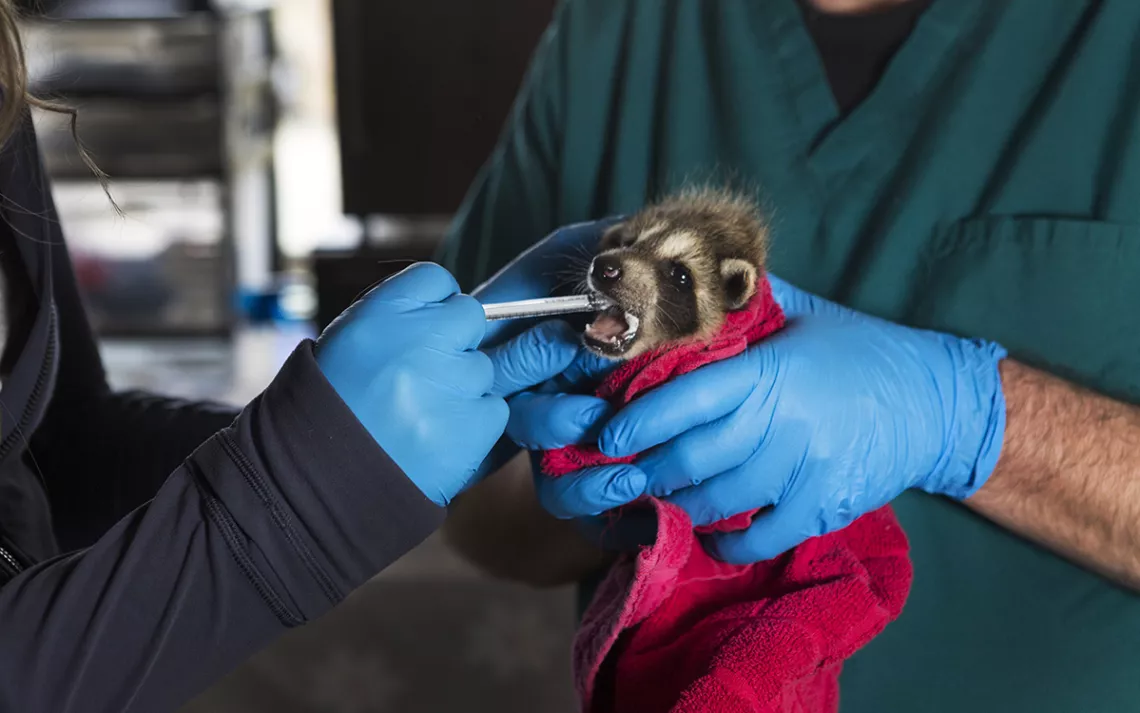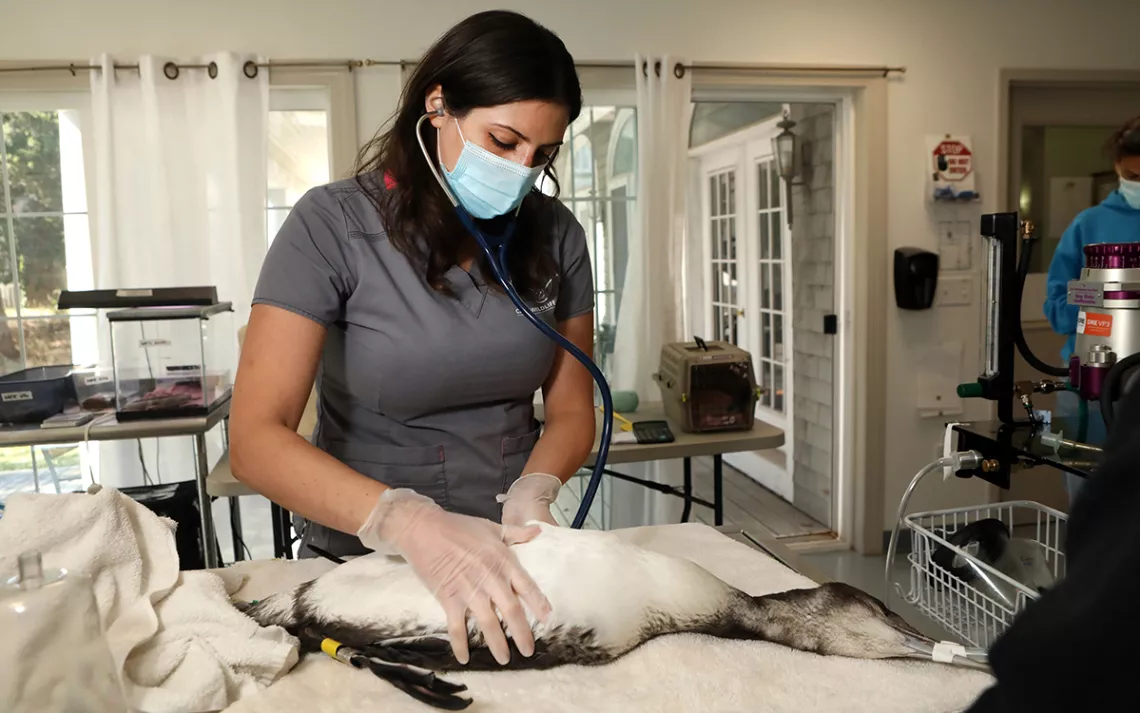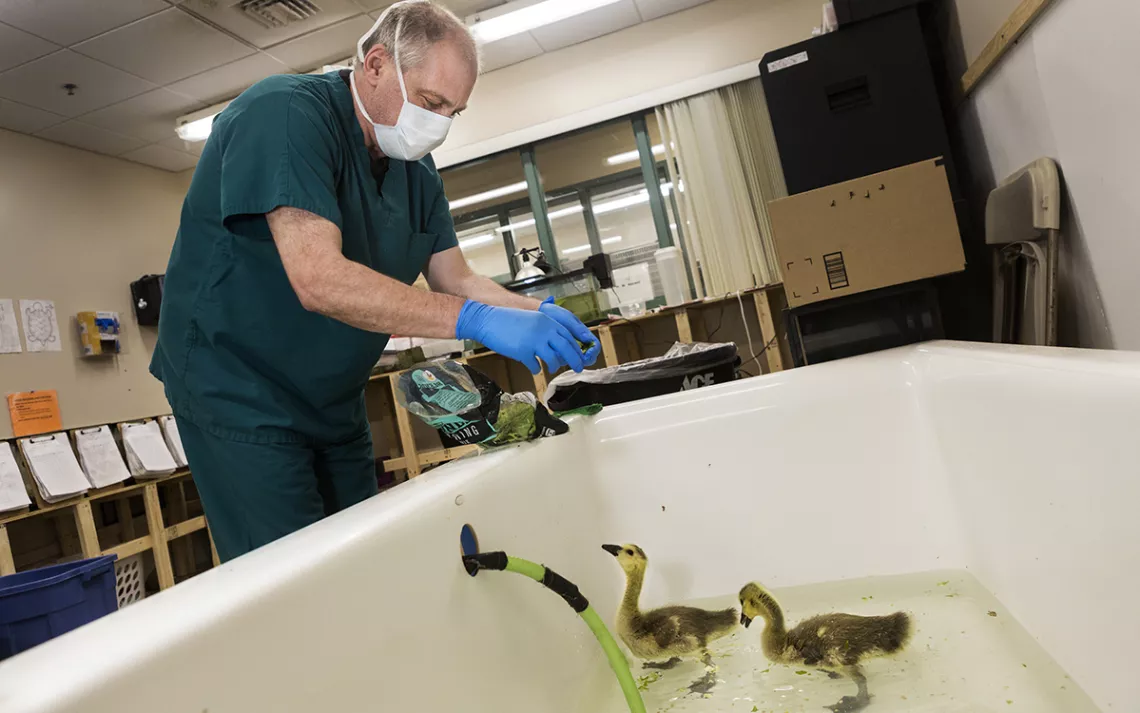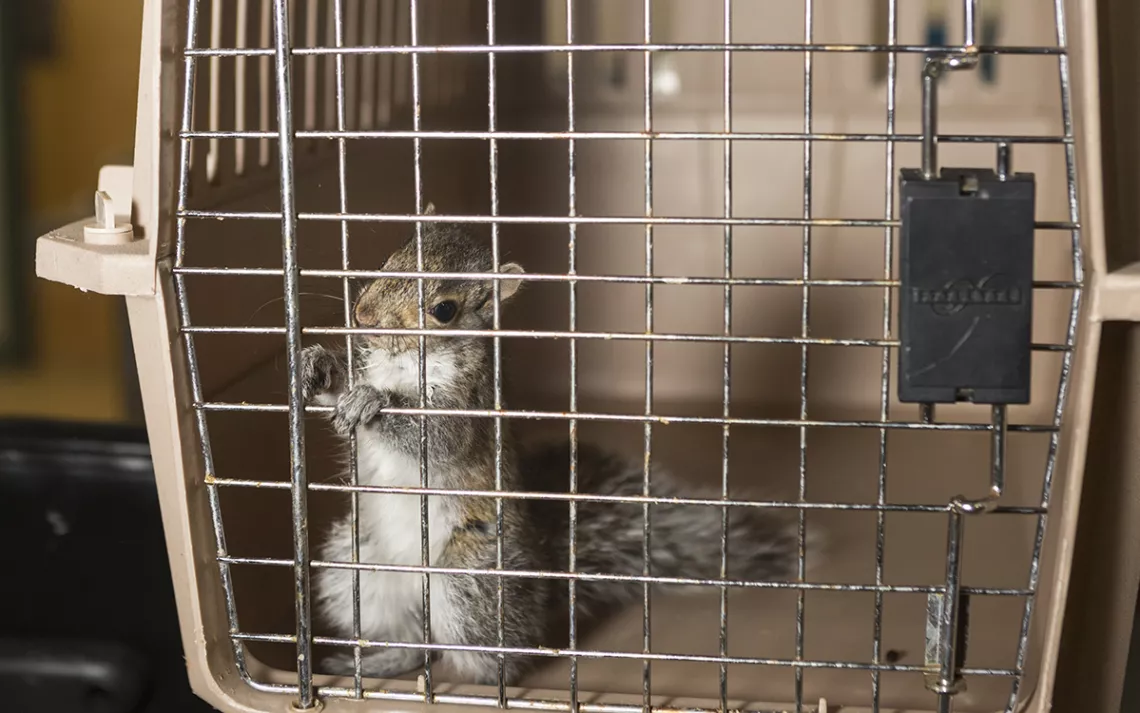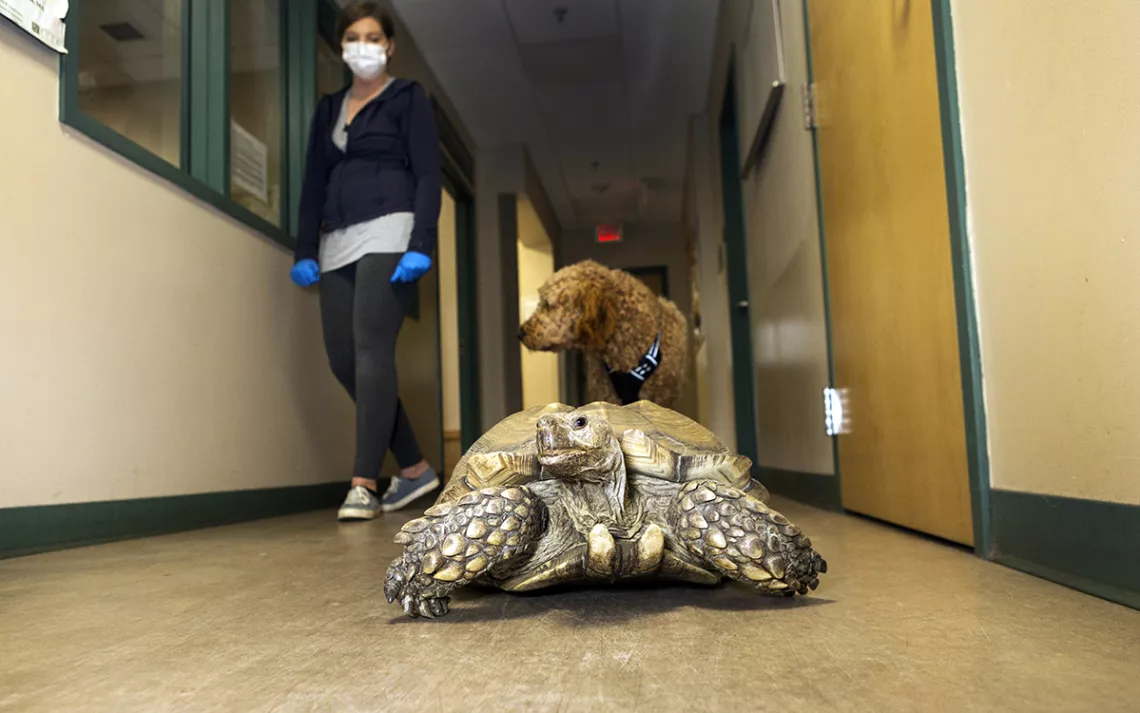The Other COVID Nurses
The epic task of rehabilitating wildlife during a plague
Photographs by Lauren Owens Lambert
This story originally appeared in bioGraphic, an online magazine about nature and sustainability powered by the California Academy of Sciences.
Under the glare of surgical lights, the exposed muscle of an opossum’s right forearm gleams. The limb lies at an awkward angle above the elbow, telltale evidence of a broken humerus. The rest of the opossum (Didelphis virginiana) is almost completely covered by a neat mosaic of blue and green surgical drapes. Only the animal’s cone-shaped, white-furred snout protrudes, sprouting an airway tube that connects to an anesthesia machine.
Priya Patel, wildlife veterinarian and medical director at the Cape Wildlife Center in Barnstable, Massachusetts, hunches over the cat-size animal as she carefully threads a metal pin through the center cavity of the bone. Although she is no stranger to orthopedic surgery, this is the first time she has pinned an opossum’s leg, and the humerus is thicker than the bird bones she’s most accustomed to.
She is also facing another challenge: There is more than one opossum on the surgical table. Her patient is carrying a pouchful of tiny joeys—each no bigger than a thumbnail, eyes not yet open, mouth firmly latched onto a teat—and the anesthesia is causing her pouch muscles to relax. Patel, having anticipated this response, had wrapped a bandage around the opossum’s abdomen to make sure her joeys stay put during the surgery. She works quickly so she can get their mother off the table as soon as possible.
“Those babies need another six weeks of pouch time to fully develop,” says Patel after tying the last of her sutures. “If we hadn’t saved the mom, we could have lost all the babies too.” She is both relieved and drained after the procedure is complete.
On any given day, this kind of surgery would have been complex and intense, but today, in the midst of the COVID-19 pandemic, the challenges were amplified. In order to conform to public health and social distancing guidelines, the Cape Wildlife Center (CWC) closed to the public in March of 2020. Between that date and September, feeding the animals, cleaning their enclosures, providing medical care, and dealing with building maintenance all fell to just three dedicated staff members: Patel; CWC’s executive director, Zak Mertz; and licensed veterinary technician Robyn Rohm. Even now, the center has been operating without the full support of the dozens of volunteers who typically work alongside veterinary staff to care for up to 60 patients at a time.
“The timing couldn’t have been worse,” says Mertz. Lockdown started just as “baby season” began, and there were nestfuls of orphaned birds, rabbits, squirrels, opossums, raccoons, and many other newborns that needed to be fed—sometimes every 15 minutes. And although members of the public could no longer walk into the center to drop off an injured animal or ask questions about a wildlife sighting, they had more time than ever to make phone calls about their observations.
An outpost of the New England Wildlife Center (NEWC), the CWC is a little more than an hour’s drive southeast of Boston, situated partway down a peninsula that curls like a bent arm into Cape Cod Bay. The region is renowned for its natural beauty, with habitats that range from saltwater bays to hardwood forests. Local residents have always enjoyed the area’s parks, trails, and open spaces. During quarantine, however, with many people unable to work in an office or send their children to school, they started spending more time exploring nature—and they were encountering wildlife on a more frequent basis. At the CWC, the phone was ringing off the hook.
While not all the calls were about sick or injured animals, Mertz didn’t want to risk missing an emergency, so he resorted to forwarding calls from the center’s main phone number to his mobile phone. Three A.M. inquiries about raccoons on back decks or coyotes on the prowl had become common occurrences. Stretched thin, and frequently sleep-deprived, his skeleton crew had been running on fumes for months by the time I met them in the fall.
Since March, a similar situation has been playing out in wildlife rehabilitation centers across the country. Overall, caseloads at US rehab centers rose by 5 percent in 2020, according to aggregate data from the Wildlife Rehabilitation Medical Database. Like the CWC, these centers typically rely on large numbers of volunteers to help feed and care for their recuperating animals, so, in the absence of that, even a modest uptick in caseloads has caused them to be swamped.
And the intake numbers at wildlife centers tell only half the story. With understaffed centers able to take only the most critical cases, licensed home rehabilitators have stepped up to fill the gap, nursing many more animals back to health in their living rooms, bathrooms, and backyards. Each opossum, owl, cottontail, or turtle they have collectively rehabilitated this year is evidence of the tremendous dedication and passion they have brought to their work since the pandemic began. But how long might they need to—or be able to—keep it up?
****
In late September, six months into the quarantine, I met with Greg Mertz, executive director of the NEWC, to tour the organization’s primary facility in Weymouth, a suburban town about 20 miles southeast of Boston. Part animal hospital, part community center, the sprawling, three-story building was in pre-pandemic times a bustling hub of nature exploration and rehabilitation, regularly hosting homeschoolers on field trips, visiting veterinarians, music jam sessions, and even incubator programs for entrepreneurs. Today, the cavernous lobby almost echoes with emptiness as I step into the building.
“What you are missing is all the people,” says Mertz, a tall, broad-shouldered man whose gray hair spills out from under his ball cap. It’s no coincidence that the longtime NEWC director shares a last name with Zak Mertz, who runs the organization’s CWC outpost. Greg has led the NEWC since 1990, and both of his sons grew up in the wildlife rehabilitation community. Zak, his eldest, trained as a hydrologist before being “willingly drafted” into becoming CWC’s executive director, a role that suits his never-ending enthusiasm for educating anyone, anytime, anywhere, about wildlife. Greg’s younger son, Harry, worked in the Weymouth center as a veterinary technician before leaving in mid-August to begin veterinary school in Los Angeles.
For the first few months of the lockdown, Greg tells me, Harry and one intern were the only two people working on-site to keep the Weymouth facility running. In order to quarantine and care for all the animals, they lived in the upstairs dorm rooms and worked overlapping nine-day-on, seven-day-off schedules, tirelessly preparing and giving medications, delivering meals, cleaning cages, and returning phone calls. By September, there were a few more employees in the building, but the animals still far outnumbered the humans.
With the deliberate stride of someone used to watching out for things underfoot, the elder Mertz leads the way past a succession of wards on the first floor. Steel enclosures line the wall of one recovery ward, and he flips a towel away from one of them to reveal the motionless body of a great horned owl (Bubo virginanus). Earlier that day, a family found the owl collapsed under a tree in their backyard. The injured bird started having seizures shortly after it arrived at the center, so Mertz sedated him. Now they are waiting for the medication to wear off—and hoping the seizures don’t resume.
“It’s probably head trauma from his fall,” says Mertz, who has been practicing veterinary medicine for more than 30 years and seen plenty of similar injuries in the past. In addition to caring for wildlife at the center, he runs a commercial veterinary practice at the NEWC that specializes in exotic pets, a background that has prepared him well for the wide variety of animals, injuries, and diseases his team deals with at the centers.
In another darkened recovery area, a great blue heron (Ardea herodius) stands in the middle of the room, slowly shifting its weight from one long-toed, webbed foot to the other. An hour ago, Mertz had sedated the animal to pick out the multipronged hook that was pinning the bird’s long bill to his right shoulder. He scoops the pieces of the hook off the counter to show me, and they fill the palm of his large hand. As soon as the heron shows that he can use his neck and jaw well enough to catch prey, he’ll be back at the water’s edge.
The average length of stay for any given patient at the NEWC is 42 days, Mertz says, so each time he takes on a new animal, he knows he could be signing his overworked team up for a significant new commitment. In addition to the physical demands that come with a relentless caseload, caring for critically injured wildlife can also take a heavy emotional toll, especially during a pandemic.
Almost a third of the center’s patients die within the first 24 hours of arriving at the facility, either because of the severity of their injuries or disease, or from the stress of being rescued and transported to the center. But even after the past six grueling months, Mertz and his skeleton crew are still accepting new patients, because they know the animals would have no chance of survival without their help. And whether an animal survives or not, each one that comes through their doors can provide valuable information about the health of a species or its habitat.
Earlier in September, a common loon (Gavia immer) arrived at NEWC with an injured leg. Colored leg bands identified the bird as part of a multiyear project, led by the Biodiversity Research Initiative, to help these iconic birds reclaim their historical range in Massachusetts. In the late 19th century, humans drove loons to near extinction in the state, and the birds have been slow to recover. With help, nesting pairs are now once again raising hatchlings in the southeastern part of the state.
While the NEWC team was ultimately unable to save this particular loon, they were, at least, able to notify scientists about the bird’s fate. Andrew Vitz, the Massachusetts state ornithologist, was relieved to learn that the loon’s death was not the result of a health issue that might threaten the area’s expanding population. For Patel, the CWC medical director who treated the bird, this case helps to illustrate another reason why she and others have put in so many long days since the quarantine began. She knows they are doing more than just treating individual animals—they are also helping entire populations.
****
Across Massachusetts, there are currently 186 people licensed by the state’s Division of Fisheries and Wildlife to conduct in-home rehabilitation for injured wildlife. Whether these volunteers specialize in just one species or tend to a veritable menagerie of animals, most of them spend hundreds of hours each year nursing injured wildlife back to health. For the past five years, NEWC staff have held training classes for aspiring “rehabbers” who hope to join their ranks and acquire a wildlife rehabilitator license.
In addition to helping these volunteers study for the state-issued permit test, they have also forged relationships that have proven to be invaluable in recent months. While the staff at both the Weymouth and Barnstable centers have continued to accept new patients throughout the pandemic, for the most part, they have been able to accommodate only the most seriously injured animals. Since March, they have handed off many of the orphans and other animals in less-critical condition to local in-home rehabilitators.
“It was scary when we received an email that the wildlife centers were closing doors to the public and reducing hours,” says Sue Cowan, a 21-year rehabbing veteran who holds both state and federal permits. “My first thought was, ‘Here we go.’ And then we got inundated.”
This year, faced with such overwhelming demand, she decided to take in only migratory birds, which are harder to place since rehabbers are required to have a federal permit to work with them.
“I’m that crazy duck lady,” laughs Cowan. At one point this year, 26 Canada goslings (Branta canadensis) filled wooden brooder boxes in nearly every room in her house, including the bathrooms and hallways. There were even incubators on the kitchen counter. “All you could hear all day long was beep, beep, beep,” says Cowan. “But it was a happy sound.”
At the start of the year, Susanna Tuffy, a wildlife rehabilitator who lives in Duxbury, planned to reduce the number of animals she took in. But that was before the NEWC closed its doors to the public.
“Then we all opened our doors back up,” Tuffy says of the rehabber community. This year, she’s cared for close to 100 animals, ranging from newborn birds and rabbits to skunks, squirrels, and snapping turtles. Her niche is mostly small mammals.
Tuffy’s home is located at the end of a long, narrow drive flanked by tall trees. The gray shingled house backs up to forested acres of private property. About 100 yards away from the house, a large snapping turtle, a former successful release, presides over a pretty pond fringed with cattails. State rehabilitators’ regulations allow rehabbers to release healthy animals either on their personal property or within five miles of where the animal was found.
Tuffy’s basement was supposed to be an art studio. Now it holds tanks and cages and crates. Behind the house, tall wood- and wire-screened enclosures stand like sentinels. One of them is currently occupied by two squirrels (Sciurius carolinensis) that are chasing each other in and out of an open door. This “soft release” allows the animals to gradually venture farther beyond their temporary haven—until, eventually, they don’t return.
“I used to be so distressed by injured animals,” Tuffy says of her motivation to do such hard, potentially heartbreaking work. “Now I realize I can do something about it.”
She is fortunate to be able to schedule her “real” job as a mental health worker around the animals’ feeding schedules. Like all rehabbers, she is a volunteer, and she pays for all of her own supplies and animal feed.
“People ask me why I bother,” Tuffy says in a soft voice. “Have you ever thought about the huge impact that humans have on wildlife? This is my small part of trying to make up for what we have done to all of them.”
****
In May, the CWC received a trio of red fox kits (Vulpes vulpes), each rescued for a different reason: One had been hobbled by a plastic six-pack ring that cut so deeply that the skin had grown over it; another was a days-old orphan discovered and rescued by chance; the third was found with a debilitating parasitic skin infection by a student at a nearby college. When they were all close to the same size, the staff put them in a joint enclosure to nurse them back to health together and give the youngsters a chance to socialize and learn more fox-like ways from one another.
After nearly five months of rehabilitation, the fox kits are finally ready to be released into the wild. On an overcast fall day, I join them on their journey from the CWC to their new home. Loaded into separate dog crates and stowed behind the last bench seat in a transport van, the kits sit silently during the ride, announcing their presence only through the musky odor that slowly fills the van.
Zak parks the van at a sandy spot overlooking one of five vernal pools on the property, a 68-acre conservation area on the southwestern tip of the cape that escaped becoming a housing division.
“There’s a lot of proper woods here,” says Philip Lang, field supervisor for the Falmouth Department of Natural Resources, as he waves an arm toward stands of pine and oak trees. He prides himself on knowing every nook and cranny of the area, and he found the perfect spot for this release. “There’s an estuary, a bay, a meadow down to the ocean; a fox might use a little bit of each.”
Whenever possible, the CWC staff try to return animals to the property they came from. But these three kits were raised together, so, although foxes are typically solitary animals, this trio can be a support system for each other, explains Zak.
We open the back doors of the van and prepare to carry the blanket-covered kennels to the preselected release spot a few hundred yards away. The process is familiar to Zak, who grew up accompanying his father on release trips for wild turkeys, hawks, otters, and countless other animals.
We walk until the sandy path offers a long line of pine trees along one side and a view of the vernal pond on the other. Although there are hiking trails on the property, we are the only humans in sight. Zak and his team set the cages down side by side, facing the empty trail ahead. Dog leashes are clipped to the doors so everyone can stand behind the cages when they pull the doors open.
One at a time, the foxes are freed. The first looks back quickly before he lopes down the trail and disappears into the trees. The second scrambles away in a whirl of spindly black legs. The last lifts a black-tipped nose into the breeze and trots down the trail, bushy tail extended, then makes a hard right turn into the woods. Everyone stares for a moment into the space where the foxes once were.
“That went so quick, but that was the end of five months of a lot of work,” says Zak, still looking toward the line of trees. The others nod in agreement. Perhaps each is thinking about their role in rehabilitating, nurturing, and then, finally, returning these animals to the wild—jobs made so much harder during the pandemic, when so few hands were available to help with that arduous journey. It is work they will do again and again, likely without much additional support for at least the next six months. Slowly, a grin spreads across Zak’s face: “All worth it,” he says.
 The Magazine of The Sierra Club
The Magazine of The Sierra Club
